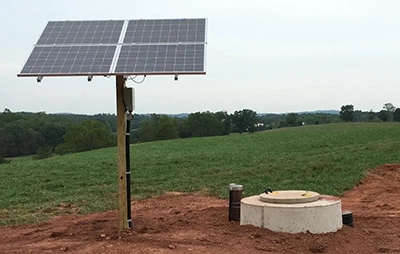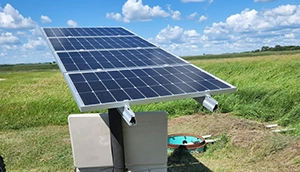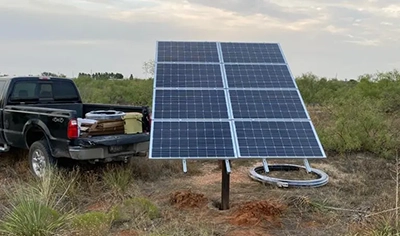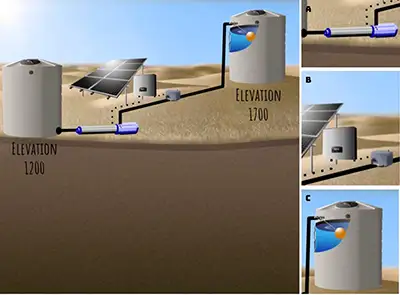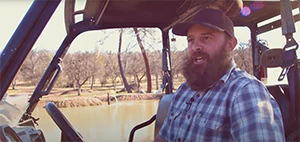Doug’s Slow Flow Livestock Well
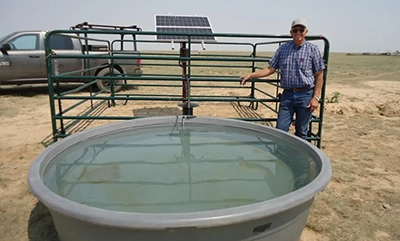

Colorado
“Doug’s Slow Flow Livestock Well”
Installed:
RPS 200
Top-of-Pole Solar Panel Mount Kit
Doug’s Ranch in Colorado
I’m 73 years old so I’ve quit ranching and farming and I’ve leased my places out. But I still take care of the water and all of the fencing and have replaced six windmills with solar pumps on my own ranch.
Our land here is semi arid and sandy loam. Some of it is real sandy, if you ever heard of the Dirty Thirties, when farmers cut all the grass off and the land blew away, that’s where we’re at. We’re 70 miles east of the Rocky mountains, we kinda live on a high desert plain.
Dealing With Drought
We’re going through a very severe drought right now, that’s why you don’t see any cattle on the pastures. There’s no cattle right now where we put this pump or where we’re going to put the next one, but if it starts raining next spring we’ll move our cattle back in.
Install Experience
That’s the first time I’ve used your RPS pump and pumping system, and I thought it went really good. We’re about 70 feet deep for the well and have 19 feet of standing water, the water level wasn’t anything to worry about. We decided to go with RPS because the pumps that I use are 4 feet long and the in-take is about a foot from the top. The next well that I’m working on has only 3 feet of water. I had to go to RPS because I needed a good pump with an intake that is only 14 inches from the bottom of the pump, which is ideal for the 3 foot of standing water.
Putting all the wires together and putting them down was a little different than what I’m usually doing. I liked the extra low level sensor. Just seemed like it went real smooth and the instructions were real good. My wife helped me and we just put it right in without too much difficulty.

Using the Motor Speed Dial for a Low Producing Well
This was for a neighbor, we helped her put it in. Where we live it is so cold that you have to protect your pump from freezing. Our weep hole was a little bit too big so I had to pull the pump back up and tape that weep hole which is about 3-4 feet below the surface (of the well). I drilled a smaller hole and that really helped the situation. The well itself only produced 1.5 gallons per minute. I really liked that power switch that you can control from a number 1 to a number 10, we’re on about a number 2, it’s really nice to be able to tailor the power to the amount of water that the well would produce. I turned that dial up to 3 and it just quit because it ran out of water, it’s pretty easy to dials it in, you just keep backing your dial off until your pump keeps running steadily. Because of the dial, we could control the power and the well didn’t really run out of water, so we didn’t need to use the timer to kick it back on.
Using an RPS Pole Mount
I put your mount on there, I was worried about what your RPS system was like with the control box, it was the first time I ever put one in with a sensor box like you have. The only thing I did on my own was put the pole in and the rest was from RPS.
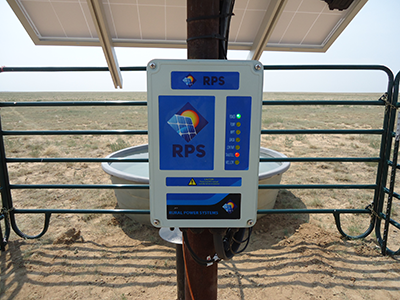
RPS 200 vs. RPS 800
You know what I like about that eight panel (the RPS 800)? If you just have the two panel system about 4:30 PM or 5 PM in the evening it quit pumping. But the one with the eight panels was still pumping about ten after 6 PM. And then it went over the next morning about 7 AM, it went to pumping again and it’s just because it has more surface area to gather in light.

